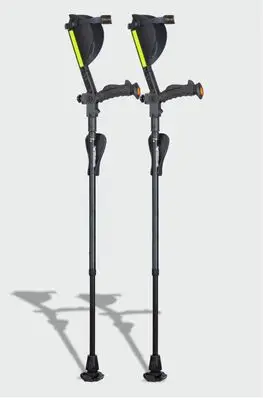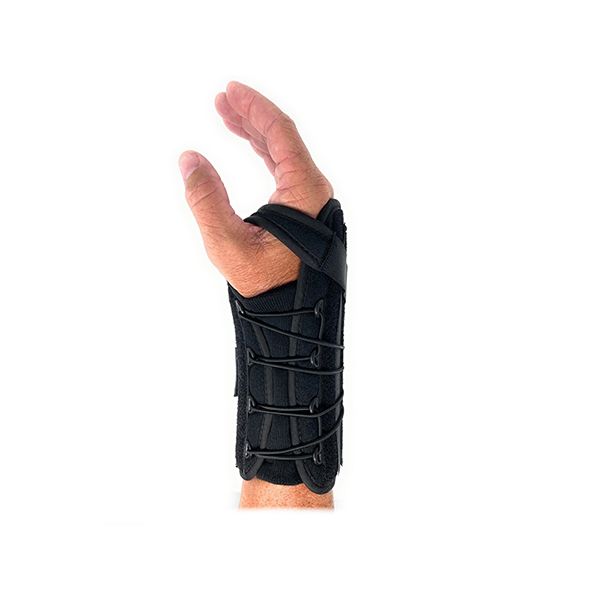
Wrist Brace - Universal
A Wrist Brace is an orthopedic device designed to support, stabilize, and immobilize the wrist joint. It is commonly used to treat a variety of conditions involving the wrist, including injuries, chronic conditions, or post-surgical recovery. The primary purpose of a wrist brace is to reduce movement in the wrist to allow for healing and prevent further injury, while still allowing functional use of the hand and fingers.
SUGGESTED HCPC: L3908
ORDER NUMBER: 340-R, 350-L
SIZE: Universal
PRODUCT HIGHLIGHTS:
• Universal sizing
• Adjustable dorsal stay
• Constructed of lightweight, breathable material
INDICATIONS:
Carpal tunnel syndrome, sprains, strains, tendonitis, wrist immobilization and post cast healing.
SUGGESTED HCPC: L3908

Table of Contents
Crutches and Canes
Crutches and canes are mobility aids used to support people with temporary or permanent physical disabilities, injuries, or impairments. Both devices help redistribute weight away from the lower limbs and assist with balance and stability during walking or standing.
Crutches
- Crutches are typically used by individuals with leg injuries, surgeries, or conditions that prevent them from putting weight on one or both legs. They are designed to support the body through the arms and upper body, allowing the legs to heal.
Types of Crutches
- Axillary (Underarm) Crutches:
- Design: These crutches are placed under the armpits and have a handgrip for the user to hold.
- Common Uses: Axillary crutches are often used for short-term injuries such as leg fractures, sprains, or post-surgery recovery.
- How They Work: The user places the crutches under their arms and presses down on the handgrips to lift and move their body forward, keeping the injured leg off the ground.
Forearm (Lofstrand)
Crutches
- Design: These crutches have a cuff that fits around the forearm and a handgrip. They are more compact and lightweight compared to axillary crutches.
- Common Uses: Often used for long-term or permanent conditions requiring extended use, such as cerebral palsy, multiple sclerosis, or post-polio syndrome.
- How They Work: Forearm crutches provide more freedom of movement than axillary crutches and are easier for users to maneuver in tight spaces.
Platform Crutches
- Design: These crutches have a platform on which the user rests their forearm, with the hand gripping a vertical post.
- Common Uses: Ideal for individuals who have difficulty gripping due to arthritis or other hand/wrist conditions.
- How They Work: Instead of relying on hand strength, the user places their forearm on the platform to support their weight.
Benefits of Crutches
- Weight Distribution: Crutches allow users to shift their body weight away from the legs, reducing strain on injured or recovering limbs.
- Improved Mobility: By using crutches, individuals can move around more easily, even if they are unable to bear weight on one or both legs.
- Injury Recovery: Crutches are essential for ensuring that individuals avoid putting pressure on healing bones, ligaments, or muscles.
Considerations for Crutches
- Upper Body Strength: Using crutches requires good upper body and arm strength, as the hands, arms, and shoulders bear much of the user’s weight.
- Proper Fitting: Crutches must be fitted correctly, with the top of the crutch positioned about 1-2 inches below the armpit and the handgrip at hip level.
- Risk of Nerve Compression: Improper use or prolonged reliance on axillary crutches can lead to nerve compression in the armpits, resulting in numbness or pain in the arms.
Canes
Canes are generally used by individuals who need less support than crutches. They help with balance and weight distribution and are often used by elderly individuals or those with mild mobility impairments. Canes are designed to provide support by allowing the user to lean on the cane as they walk.
Types of Canes
- Single-Point Cane:
- Design: A cane with a single tip at the bottom, typically with a curved or ergonomic handle.
- Common Uses: Ideal for individuals with mild balance issues, arthritis, or joint pain who need extra support while walking.
- How It Works: The user holds the cane in the hand opposite the affected or weaker leg, helping distribute weight and improve balance.
Quad Cane
- Design: A cane with a four-pronged base for greater stability and balance.
- Common Uses: Beneficial for individuals with more significant balance problems, muscle weakness, or neurological conditions like stroke recovery.
- How It Works: The wider base provides more stability, making it easier for individuals to maintain their balance on uneven surfaces.
Folding or Adjustable Canes:
- Design: These canes can be collapsed for easy storage and adjusted for height.
- Common Uses: Suitable for individuals who travel or need a cane only occasionally.
- How It Works: The user can adjust the cane’s height to their comfort level and fold it when not in use.
Offset Cane:
- Design: Features a handle that is positioned forward from the cane’s base, offering better weight distribution.
- Common Uses: Helpful for individuals with wrist or hand pain who need better balance and support without the strain on the hand.
- How It Works: The offset design allows for a more comfortable grip and improved stability.
Benefits of Canes:
- Balance and Stability: Canes provide a stable support point, reducing the risk of falls and helping individuals with balance issues walk more confidently.
- Weight Relief: Canes can help transfer a portion of body weight from the lower limbs to the upper body, relieving pressure on joints and muscles.
- Ease of Use: Canes are relatively easy to use and don’t require as much upper body strength as crutches.
- Portability: Canes are lightweight and easy to carry, store, and transport, making them a convenient option for people with mild to moderate mobility challenges.
Considerations for Canes
- Proper Height: It’s essential to ensure that the cane is the correct height. The handle should be at the level of the user’s wrist when standing straight with their arms relaxed.
- Gait Training: Using a cane effectively often requires instruction from a physical therapist to ensure proper gait and weight distribution.
- Support Level: Canes provide less support than crutches or walkers, so they are better suited for individuals who need minimal assistance with mobility.
Key Differences Between Crutches and Canes:
- Support Level: Crutches offer more support and are used for individuals who cannot bear weight on one or both legs, while canes are for people who need only minimal assistance.
- Upper Body Requirement: Crutches require more upper body strength and coordination, whereas canes are easier to use and require less arm strength.
- Mobility Needs: Crutches are often used for temporary, serious injuries or post-surgery recovery, while canes are typically for long-term use in cases of mild balance issues or chronic conditions.
Both crutches and canes can greatly improve mobility and independence for individuals with injuries, surgeries, or mobility impairments. They must be used correctly, with appropriate fitting and guidance from a healthcare professional, to maximize their benefits and prevent complications.

